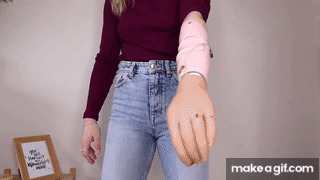This is invasive works.
My original first prosthetic arm was around 3-4 cm too long. My prosthetist said it was not possible in any other way and that I should put up with this. As one can see from other prosthetic arm users, that type of unacceptably sloppy work does not seem to be an exception. However, it may be understood in overall context of prosthetists trying to discourage arm amputees from using / wearing body powered technology.
At any rate, wearing a prosthesis that is too long caused me serious shoulder and neck pain from asymmetric loading. So I personally identified that as medical indication to get the length of my prosthesis fixed, so it would be good.
Mounting the wrist at the end of the socket is a part of that problem. The longer the stump, the less space for a wrist connector there.
To get my relatively long stump (~6cm behind wrist) to still allow for correct socket length, and to allow usage of regular components, we did some things.
My wrist (see series description) has a central bore (image below, left). This is necessary to allow for the pin to protrude through the pin lock (hole, image below, right) into the wrist space.
My socket (image below, right) contains an Ossur Icelock. As I figured out, its distal metal plate (round shiny plate) is quite thick and so lots of that material can be milled down without problems. The lock still works perfectly well.
So if it is necessary to achieve a correct length (not an over length) for long below elbow stumps, grinding down parts and keeping at it is the way to go. This is what I did to my socket that was 2-3cm too long: as proof of concept, I reduced the length dramatically and took the resulting shortened socket to the prosthetic technician to clean up. Now I have two perfectly measured sockets.

Looking at the cross section of the end of my shop-issued socket (diagram, left), the wrist (w) sits on top of some epoxy (e) that constitutes the end of the socket and holds the pin lock (pl) in place.
I removed a lot of bulk (diagram, middle, “remove”) and milled down into the metal plate of the in lock (pl) to gain another 3-5 mm. Even the plastic unlock button does not require a full casing, that can be partly removed as well.
The result (diagram, right) is an extremely tight construction that only works if the wrist has a central bore.

Disclaimer: I knew what I was doing. If you don’t get it right, you risk damaging possibly expensive parts. So you are definitely on your own with this.


